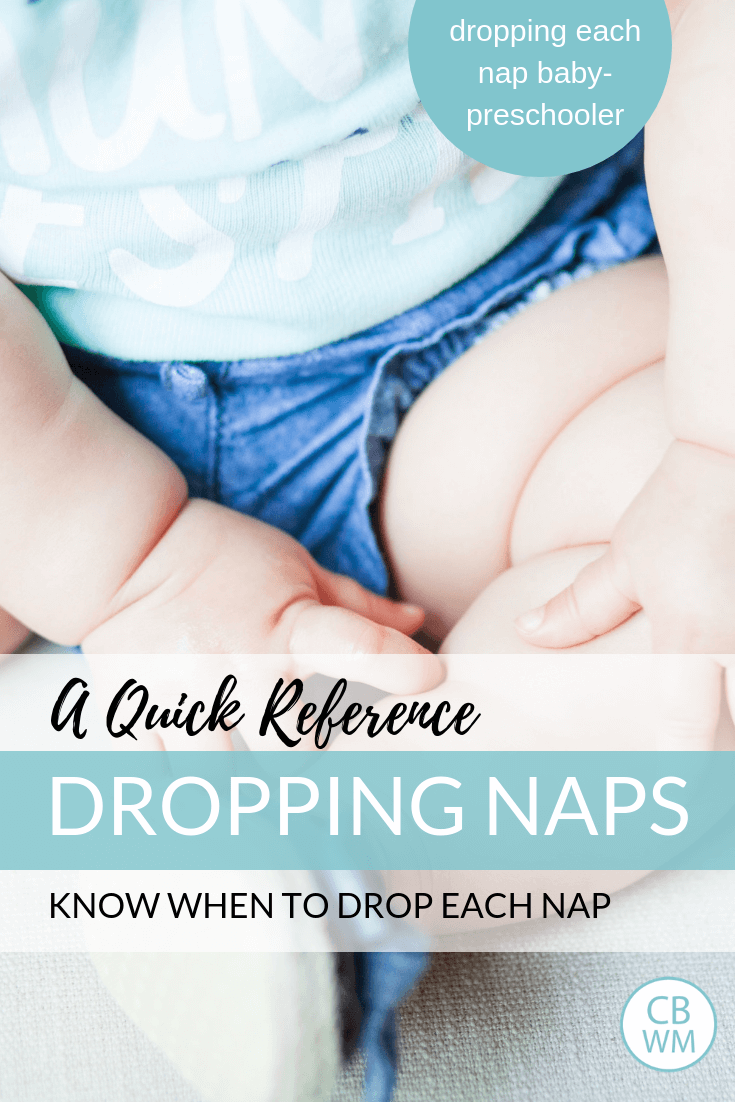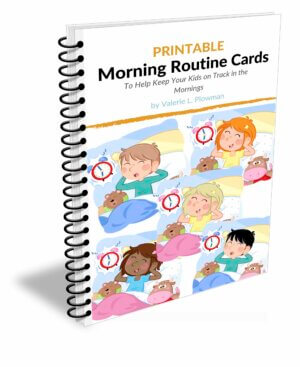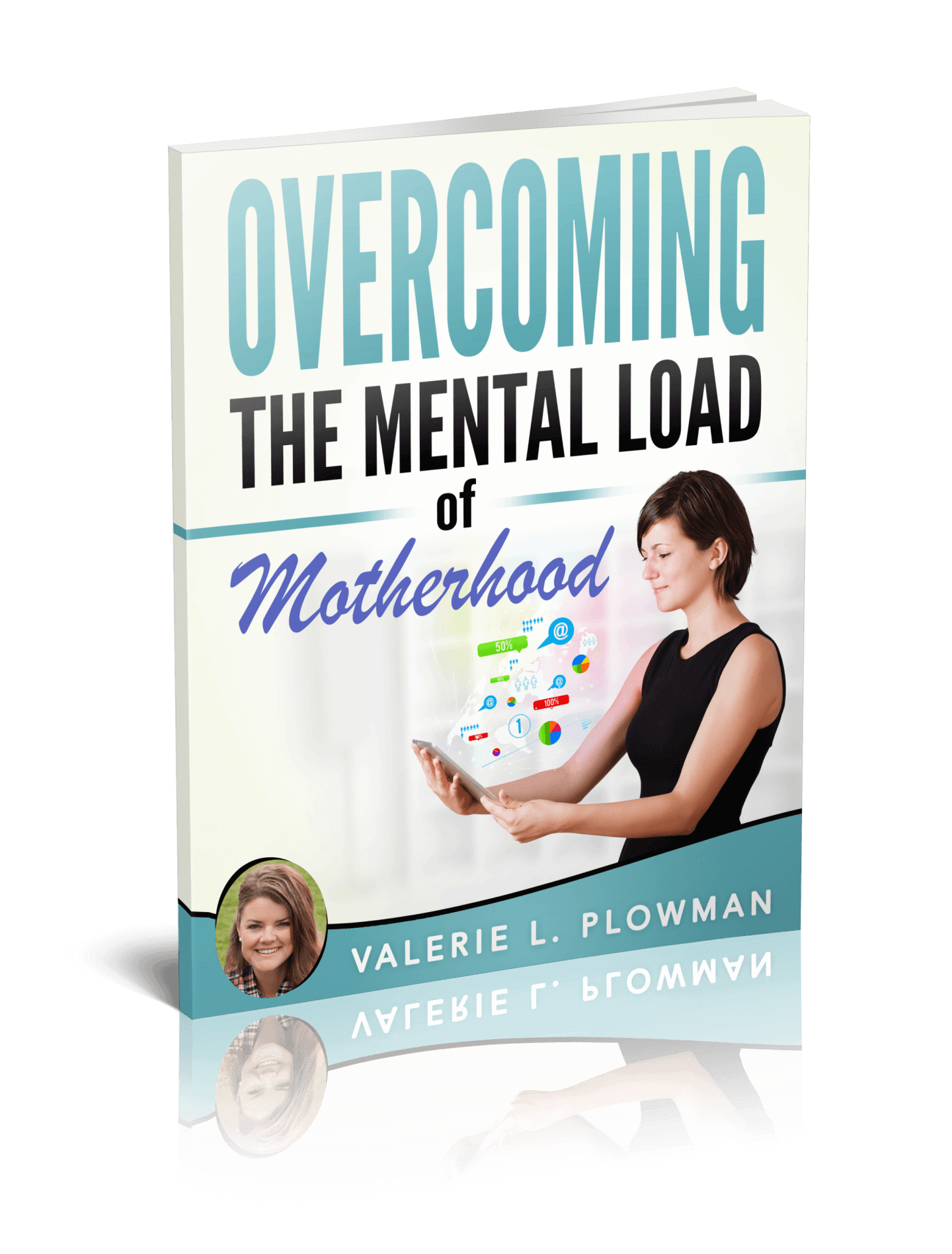Dropping naps. When to drop naps for babies and preschoolers. Sleep drops for babies through dropping the afternoon nap. Guidance for dropping all naps.
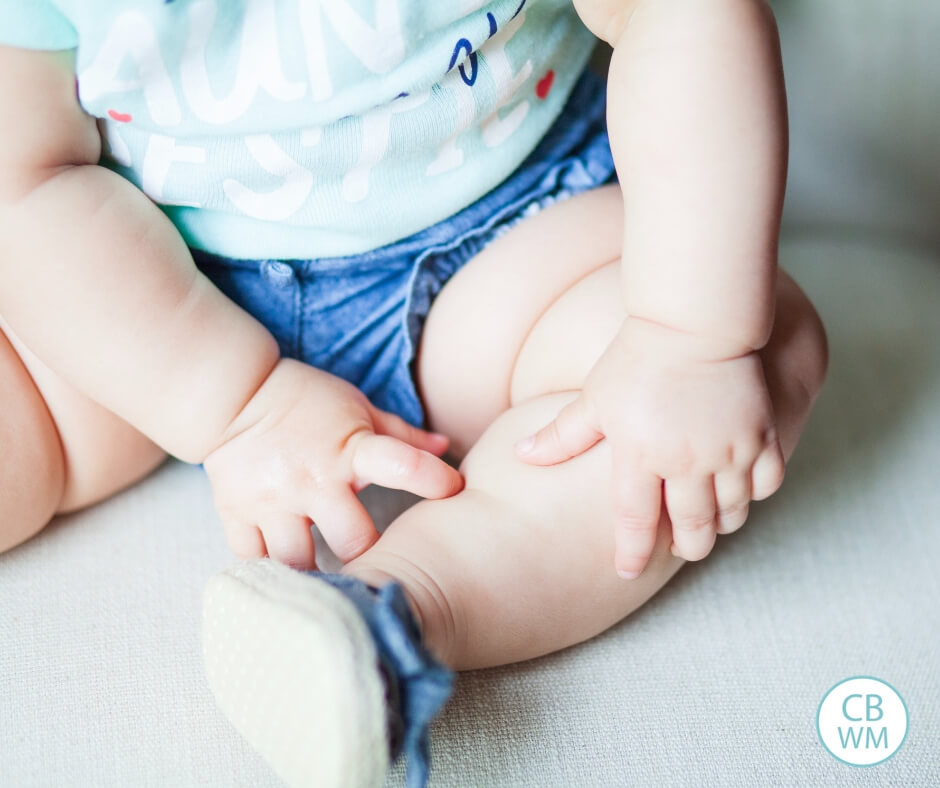
Timing and signs of readiness for dropping naps is always a question for parents, even those who have done it all before. It can be hard to remember all of the details. Here is a synopsis of the various naps, timing of when to drop them, signs that your child is ready to drop them, and methods for doing so.
Post Contents
Dropping the Fourth Nap
First, we need to define nap times for newborns. I consider any sleep that happens after 7 PM to be bedtime. So a newborn who eats around 7ish, then goes to sleep (this could be considered a nap by some), and wakes again to eat around 10ish, in my definition would have gone to bed after the 7ish feeding. My reason for this is that baby never drops that sleep between 7 and 10. Baby drops the feeding around 10 at some point.
The fourth nap is the nap that occurs between 4ish and 7ish PM.
AGE: I have found the average age for this nap to be dropped is 4 months old. Some babies are ready earlier (but really no earlier than 3 months) and some are ready later (but few later than 5 months). Your two month old is not ready to drop this nap. Your six month old is way beyond ready to drop this nap.
SIGNS OF READINESS: For most babies, the sign for this nap to be dropped is that baby really doesn’t sleep well for it anymore. Note the word anymore. This is a typical fussy time of day for babies when many don’t sleep well in general.
Don’t assume your 4 week old doesn’t need this nap because he isn’t sleeping well. By four months of age, baby is most likely playing around during “naptime” instead of sleeping. Some babies might sleep for this nap but then have a hard time going down after the 7ish feeding. Others might have sudden disrupted sleep at night.
Another sign would be that your child is ready for a 4 hour schedule. A 4 hour schedule will naturally drop the fourth nap.
METHODS FOR DROPPING: One easy method is to move to the 4 hour schedule if your baby is ready. Many babies will naturally drop this fourth nap as they move to the 4 hour schedule. As you extend your schedule, you drop feedings. As you drop feedings, you drop number of naps. Other babies are ready to drop this nap before they are ready to move to a 4 hour schedule. This was true for both of my children.
If your child is ready to drop the nap but not ready for a 4 hour schedule, you just skip the nap. Take note that the last two feedings might then move closer together because a baby can go longer between feedings if he is asleep than he can when he is awake. He also might need a bit earlier of a bedtime (30 minutes or so), at least for a few days while he adjusts. Some babies will be fussy for a few days as they adjust to the new sleeping arrangement.
One note, if you think your child is ready to drop this nap and is still taking a 1.5-2 hour nap at this time, try shortening the nap at first. Perhaps down to 60 minutes, 45 minutes, or 30 minutes.
>>>Read: Moving Baby From 4-3 Naps: All You Need to Know
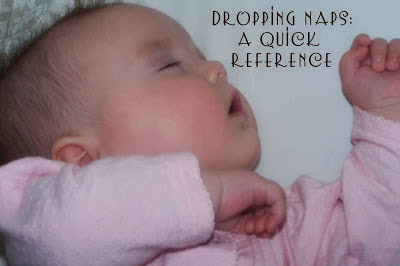
Dropping the Third Nap
The next nap you drop is the evening nap, or 3rd nap of the day. By the time baby is ready to drop it, it is usually a short 45 minute nap. Your baby will be on a 4 hour schedule by this point, so the nap will again be somewhere between 4 and 7 PM.
AGE: According to On Becoming Babywise I and II, this happens relatively young (around 6-8 months).
This can vary from child to child. The youngest it should be will is 6 months. The average seems to be 8 months. My son didn’t drop his until he was about 10 months old. I was reading Babywise and realized he was not supposed to need it, so we dropped it. My daughter didn’t fully drop it until she was 11 months old.
SIGNS OF READINESS: It can be hard to tell just when your baby is ready to drop this nap because it is already short. One sign is if your baby doesn’t seem tired enough for bed after napping in the evening. Other signs can be the same as the fourth nap: baby doesn’t sleep for that nap at all, baby doesn’t go to bed well after taking that nap, or baby doesn’t sleep well at night.
METHODS FOR DROPPING: This is a nap you skip. Some babies might be able to go “cold turkey,” or dropping all at once. If you choose this method, expect some fussiness as your baby adjusts. Be ready to be an entertainer. You could get a new toy or book or something to pull out only at that time of day to keep the baby happier.
You could also leave the house to keep him distracted. When my oldest dropped this nap, I remember he was cranky during the stretch for several days, maybe even a week, but his body soon adjusted. before her morning nap and still waking her up from the nap at the same time. I shortened the morning nap. I also added about 10-15 minutes to her waketime between her two naps. These actions fixed things and she was back to sleeping for both naps: 1.5 hours in the morning and 2-2.5 in the afternoon.
For some children, this morning nap might need to be shortened more than that. As I said, Kaitlyn is a sleeper. She is still taking a long morning nap though it is shorter than it was.
Another method is a weaning process. In this approach, you only give the nap if baby needs it that day. Some days baby takes the nap, other days he doesn’t. This is the method I used with my oldest daughter.
We started around 8 months to take it as a weaning process. If we were out in the evening, she didn’t nap. If we were home, I waited to put her down only if she showed signs of needing it. If she was awake and started showing signs of needing the nap 30 minutes before her normal feeding time, I fed her early and put her to bed early. At first, every few days she didn’t nap. Soon, it was every other day. Later, she napped only every few days. As I said earlier, she didn’t fully drop this nap until she was 11 months old.
Dropping this nap might move bed time up.
Read: Dropping the 3rd Nap (evening) and Dropping 3rd Nap Impact
Dropping the Morning Nap
When you drop the morning nap, you move from two naps to one nap. Dropping the morning nap is not as sad as it may seem. You suddenly have a large chunk of time when baby doesn’t have to be home! You baby will also most likely take a longer afternoon nap once the morning nap is dropped, so you have a longer stretch in the afternoon to get things done. This also gives you more opportunity for quality learning opportunities and activities in the morning hours.
AGE: Among the different “–wise” books, the ages for dropping the morning nap range from 14-22 months, and all are possible. Some toddlers do drop the nap as early as 14 months. My son was 17 months. My daughter is now approaching 19 months and still holding on to her morning nap. I am hoping for her to drop it soon, and every so often I try, but she isn’t quite ready.
SIGNS OF READINESS: For some children, this can be one of the easier naps to tell he is ready to drop. For others, it can be a real guessing game.
Classic signs of readiness are when your toddler is ready to drop this nap, he will still sleep really well in the morning, but for the afternoon nap, he will hardly sleep at all. This is when he is ready to drop the morning nap. This is how my son was.
Another classic sign is your toddler might not sleep for the morning nap but sleeps for the afternoon nap.
Your toddler also needs to be able to handle the longer wake time. Your child will go from having awake time for about two hours to having wake time from breakfast until after lunch.
For some toddlers, things can be trickier. There is a transition time when the toddler isn’t ready to drop the morning nap, but doesn’t need a full nap anymore. My oldest daughter was this way. When Kaitlyn was about 14 months, she started to not sleep well for both naps. This was extremely odd to me. She has always been a really good napper. She loves to sleep. I started to wonder if perhaps she was ready to drop the morning nap. It surprised me because she didn’t drop her third nap until she was 11 months old—I didn’t think she would be ready to drop the morning nap so soon after dropping the evening nap.
She wasn’t ready. Kaitlyn missed her morning nap once a week for church. She would then come home, eat lunch, and go to sleep for about 4 hours–making up for her missed morning nap. She was very, very tired when we got home. Tired enough that she usually didn’t eat her lunch very well. Based on this, I figured she wasn’t really ready to drop her morning nap. Instead, I started lengthening her waketime.
Others might be going through teething or some other disruption, which causes parents to wonder if it is time to drop the nap. Some might be able to start a weaning process from this nap where some days they take the nap, others they don’t. More on this is explained below.
If you feel your child is kind of ready to drop the morning nap but not quite, read this post here: Dropping the Morning Nap (from 2 to 1 naps): Transition Time
METHODS FOR DROPPING: Your toddler will take his nap after lunch. For us, naptime started at 1 PM. Some toddlers need naptime to start earlier than this, at least for a period of time. You can have lunch earlier if needed and nap start earlier. Once he is back to normal, you can have the nap move to your (and his) optimal time.
With my son, we dropping this nap cold turkey just as we had previous naps. This is one option.
You can also try a weaning process. I find this nap harder to do a weaning process for. If your toddler doesn’t take a morning nap, the afternoon nap times are very different from when your toddler does. It can be hard to plan your day. If you have an open enough schedule that you can work around this, weaning is a good first step for you. If not, you will have to wait until your toddler is more ready before dropping it. You can also consider simply being more flexible for a week or two and allowing the weaning process, planning to hopefully fully drop the nap after that.
If you think your child is ready to drop the morning nap, you can always give it a try. My guess is after two-three days in a row, you will have a good idea if he is really ready or not. I suggest having other things to do to keep your toddler preoccupied. Errands to run, people to visit, etc.
I tried dropping this nap with Kaitlyn a few weeks ago. Day one was fine. Day two, she started to fall asleep while eating lunch. I could see she wasn’t quite ready yet.
In my experience, toddlers are not as cranky after dropping this nap as they are for others. When we dropped this nap with my son, the afternoon nap went to 3.5 hours instead of 2 hours and bedtime moved up an hour.
As your child gets older, the nap will shorten and/or bedtime will move back slightly. You can find more details on dropping this nap in my post: Dropping the Morning Nap Guide
Dropping the Afternoon Nap
The afternoon nap is the only nap of the day. Your child will move from the nap to rest time. I will summarize the information as listed in On Becoming Preschoolwise (page 100).
AGE: This is typically around four years old, though age depends on the sleep needs of the individual child. I highly encourage parents to keep it a “nap” until age four if at all possible. I do not recommend this at age two. You will likely have push back from a two year old. This doesn’t mean your two year old is ready to go to no naps. I wouldn’t even entertain the idea of dropping the afternoon nap until age three at the earliest.
All four of my children waited until age four to officially move from nap to rest time.
I recommend this age because your child is ready on a maturity level to handle the freedom of knowing it is not a “nap.” It is a “rest time.” A two year old cannot necessarily comprehend that.
Read my post When Do Kids Stop Napping for more on this topic.
SIGNS OF READINESS: Your child will stay awake through his scheduled nap time very consistently.
As your child gets close to be ready, there will be nap days and no nap days. Once your child is ready to go to rest time instead of naps, you will rarely have that nap day anymore. Your child will stay awake from nap most if not all days of the week consistently.
Your child will be able to skip that nap each day and still be pleasant in the evening until bedtime.
METHODS FOR DROPPING: This nap should be “dropped” as a weaning process. You have your child lay quietly on his bed. You allow him to have a book or two to look at. You tell him if he feels tired, he should go to sleep.
This dropping process really takes years. It starts as a two year old not napping 1-2 days a week. As the child gets older, the days not napping will increase in number until most days are not spent actually sleeping.
If your child falls asleep but does so later than usual, wake him at the time naptime would normally be over, not X number of hours after falling asleep. He will likely be cranky from a short nap, so plan on him doing something to transition out of the nap (for example, watch a movie).
Over time, your child will nap some days and rest others. The transition period from naptime to rest time can take six months to one year. He will slowly decrease the number of naps he takes in a day.
If your child is cranky on days he didn’t take a nap, you can put him to bed thirty minutes early. Read up on How to Do Rest Time {Instead of Naps} here.
Tips for Dropping Naps
- Children are often cranky/fussy for a few days or so while their bodies adjust to the nap that has been dropped. Don’t mistake normal crankiness for signs that he wasn’t ready.
- Bedtime often needs to be moved up after dropping a nap, at least for a week or two while your child adjusts. For some naps, your child will move back to “normal” bedtime. For others, normal is now earlier.
- Sometimes the other naps are longer after dropping a nap.
- For babies and toddlers, dropping a nap doesn’t necessarily mean less sleep in the day. They simply rearrange the times they sleep.
- Don’t be afraid to try dropping the nap if you think your child is ready. If you try to drop a nap and find your child wasn’t ready, you can always add the nap back in.
See also: The Best Ages for Dropping Baby’s Naps
Poll Results
Here are the results from polls I have done on this blog.
Dropping Naps Ages
1-What age did your baby move from 4 naps to 3 naps each day?
3 Months: 3
4 Months: 7
7 Months: 1
Don’t remember: 2
2-What age did your baby go from 3 naps to 2 naps each day?
6 Months: 4
7 Months: 1
8 Months: 4
10 Months: 1
11 Months: 2
3-What age did your child go from 2 naps to 1 nap each day?
13 Months: 1
14 Months: 2
15 Months: 1
18 Months: 2
20 Months: 1
N/A: 5
4-What age did your child go from napping most days to not napping most days (whether doing rest time instead or just not napping)?
3 Years: 3
4 Years: 3
N/A: 6
5-What age was your child done napping consistently?
3.5 Years: 1
4 Years: 1
5 Years: 3
N/A: 7
6-Any tips, advice, and/or words of wisdom for parents out there?
Christina said: Don’t fear losing naps. When you drop a nap, your baby will usually compensate by sleeping better at night or napping longer for the other nap(s). I remember dreading it with my daughter and found that even while constantly sick while pregnant, it wasn’t as bad as I thought (time she dropped naps entirely). It is a wise idea to institute daily room time or daily quiet time, though, for non-nappers. They need to learn how to respect YOUR time.
You will know your baby’s ready to drop a nap when he/she consistently won’t sleep a few times a week for several weeks in a row. Right now I can tell my son is close to dropping his morning nap (though not completely there yet) because when he does take two naps, they are usually 45-60 minutes at the most and he won’t fall asleep as easily at bedtime (and will just sleep 10.5 hours a night instead of 11 or 11.5 hours). I know he’s not fully there yet, though, because on some days, he gets incredibly fussy at naptime and actually does sleep. So not fully there yet but close!
My daughter was ready to drop naps when she stopped napping every day and did quiet room time instead. We got to where she’d take one nap a week and the other days were room time days. I’d set rules for her (quiet activities only, stay in your room unless you need to use the bathroom, let Mommy have HER quiet time), and if she broke a rule, I re-set the timer.  🙂Worked like a charm!
🙂Worked like a charm!
But honestly, dropping or eventually eliminating all naps is nowhere near as bad as I used to think it would be.  🙂
🙂
Jennifer said: We found that what worked well for our daughter was to extend wake time incrementally until there just wasn’t time for the last nap of the day. That’s even working now at almost 18 months. She’s now awake usually 3.75 hours for each wake time, meaning that she naps right up until lunchtime, and sometimes her evening nap goes later than is usually recommended. However, she still sleeps fine at night, so we go with it. At some point we’ll have to bite the bullet and not nap before lunch and do the one nap right after lunch and make bedtime earlier, but at this point, she has not shown that she’s ready for that change to happen. I think because her naps have always been 1-1.5 hours each (and now they are usually just one hour each), she is on the late side for dropping naps since she needs the sleep. If she napped longer, perhaps she would have been ready to drop earlier, if that makes sense.
Jessie said:If your baby’s sleep is off for a few weeks, it’s probably time for a change. Also, we wanted to preserve bedtime, so we probably dropped naps earlier because we were okay with earlier bedtimes for awhile.
We are in the midst of dropping to one nap at 13 months. It is definitely on the young side, but he has always dropped early and is well rested. Doing 2 naps every day makes for early mornings and a cranky baby but doing one nap for more than 2 days in a row ALSO results in early mornings and crankiness 🙂 Alternating days keeps him happy and well rested.
Natalie said: We knew it was nearing time to drop a nap when she started to struggle against the last nap of the day. She eventually would just not go to sleep. At first her bed time would be earlier, but we would progressively lengthen her wake times to compensate. And she made up for the missing nap with the extra sleep from the early bed time.
PESTAG said: Waketime needed to increase because naps lengths were shortening due to undertired. As waketime increased, naps were dropped naturally because there wasn’t time in the day for a nap to occur. We used Sleepwise Consulting’s method of dropping to one nap, which can be found on their website. It worked seamlessly
Lisa said: No real advice but interested to hear what others said. We went from 4-3 gradually as it was in the middle of leap 4 so I was happy to be getting any naps out of her. By the end of the leap she went from 4-3 with no hassle.
